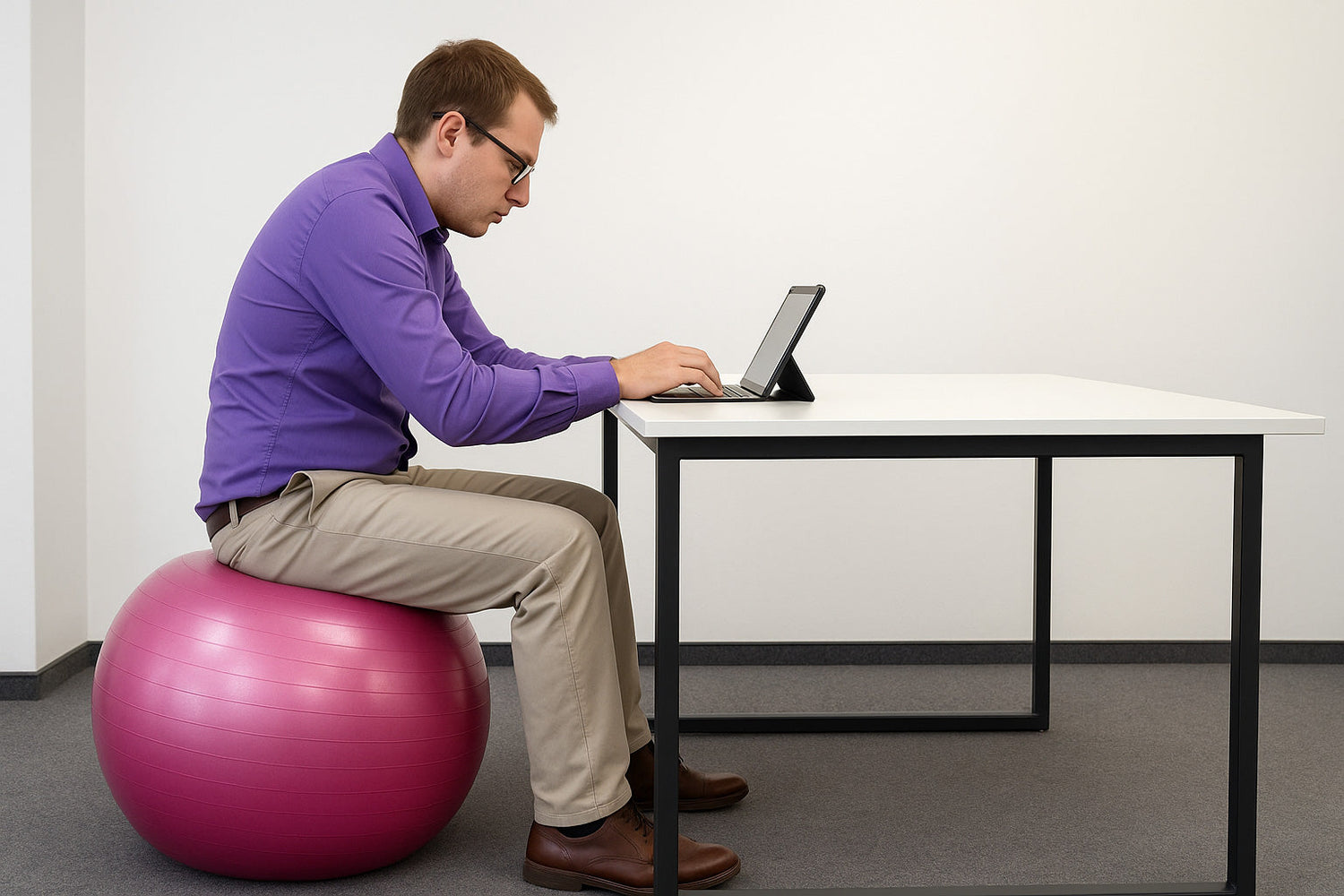It turns out yoga balls provide no real benefits and have some downsides. And there are better solutions.
Most Americans sit for many hours every day, but epidemiologists tell us that sitting still is dangerously unhealthful, shortening our lives by as much as two years1. We’ve known this for some time now, but surprisingly no clear alternative to our “ergonomic” office chairs has as yet emerged.
This isn’t for want of trying. There are many contenders to replace our chairs and the list keeps growing: yoga balls, standing desks, treadmill desks, under desk “peddle cycles”, kneeling chairs, saddle chairs, perching stools, active chairs, and others. The sheer number of offerings suggests that finding a way to fix the problems caused by sitting is an important question that isn’t yet settled.
We don’t yet know which, if any, of these contenders will ultimately replace our office chairs. But there have been some notable dropouts.
For example, yoga balls. Almost 25 years ago it was hoped that replacing office chairs yoga balls would provide a quick fix for sitting, because they were about the same height as an office chair and were associated with exercise and so seemed somehow “healthy”. And it didn’t hurt that yoga balls were also widely available and cheap.
The Origins of the Yoga Ball:
Although large balls had been used since the 1950’s in the therapy of everything from cerebral palsy to obstetrical rehabilitation, balls became much more popular after 1963 when an Italian manufacturer, Aquilino Cosani, found a way to manufacture what he called the "Pezzi Ball"—a large inflatable sphere originally intended for gymnastic exercise.
As it happened, the increasing popularity of these balls overlapped with growing concern over workplace wellness, and in particular the problems caused by passive sitting2, setting the stage for an invasion of offices by yoga balls. In 2003 a Los Angeles Times article3 announced: "These inflatable balls…, have migrated from health clubs and physical therapy clinics to offices." But this initial announcement wasn’t really an endorsement, noting that “posture experts are leery of the practice”, and further conceding that there was no research available. “I’m not sure anybody has spent a lot of dollars researching this...” observed one physical therapist at the time. Indeed.
But 20 years later the research is in, and it doesn’t support the early hoped-for advantages of the yoga ball as office furniture. The picture is perhaps best summarized by Wikipedia: “There is no scientific evidence of benefits from sitting on exercise balls without additional exercises. …, some warn against using a yoga ball as a chair because of ergonomic considerations or biomechanical reasons…”4
The Downsides of the Yoga Ball:
There are several reasons the yoga ball makes a poor chair replacement. Perhaps most problematically, the height of a yoga ball can’t be adjusted. Because posture is profoundly affected by the height of one’s seat, the fixed height of a ball is a major drawback. One could try adjusting the air pressure within the ball but who has the patience for that?
Another postural problem: although the compressibility of the yoga ball has been touted as an advantage, because it doesn’t have a defined surface it’s difficult to orient one’s sitting bones in space, and so it’s hard to vertically align one’s spine atop the ball. As a result, sitting on a yoga ball causes the pelvis to tilt backward, leading to a hunched lower back the very C-shaped posture the yoga was supposed to prevent.
And a further disappointment: It was hoped that the instability of yoga balls would invite increased movement that would boost basal metabolic rate (BMR) and so perhaps reduce the incidence of “sitting disease” (a cluster of conditions including obesity, diabetes, heart disease, and increased all cause mortality). Unfortunately, when carefully measured sitting on a yoga ball produced little increase in BMR.5 Interestingly this same study did find a significant increase in metabolic rate when sitting on active chairs, an observation that has been reproduced in other studies.67
Finally, the hope that yoga balls would simply be more comfortable than standard chairs also proved illusory. In a small study published in a 2006 in Human Factors by Gregory and coworkers concluded: “Prolonged sitting on a stability ball does not greatly alter the manner in which an individual sits, yet it appears to increase the level of discomfort. Therefore, it is important to fully explore a new chair design and consult scientific research before implementing its use.”8
How Have Yoga Balls Worked Out in the Workplace?
It’s surprisingly difficult and expensive to study how any seat design actually works out in the real world because such studies require many participants and data needs to be collected repeatedly over an extended period of time. And because the patent on the yoga ball expired long ago, there’s no real impetus to invest the money that such studies would require. So, it’s not surprising that only one such large-scale study has compared yoga balls to standard chairs. Schult and coworkers studied almost 200 office workers in a 3-month crossover trial, and found that almost half of their subjects reported pain while sitting on yoga balls.9
The Office Furniture Market Evolves
The yoga ball market has continued to innovate, but the fundamental problems haven't changed. Yoga balls that prevent sudden collapse in the event of puncture are now available, as are balls with stubby legs that prevent them rolling away. Unfortunately, these developments add expense without addressing the underlying shortcomings of the yoga ball as office furniture.
Despite the lack of documented benefit, the popularity of yoga balls as replacements for office continues to slowly grow. Office sitting hoovered up $100 million dollars’ worth of yoga balls in the USA in 2020, and sales of $200 million are forecast for 2030.10 While sales are growing, yoga balls remain decidedly a small niche product: for reference, yoga balls represent only 1% the $15 billion US office chair market.
Are There Better Alternatives to Yoga Balls?
So why have yoga balls persisted in the workplace? Mostly, I think it’s that people hate their chairs and are desperate for a better solution to the problem of sitting. Fortunately, there are better alternatives to office chairs than off-the-shelf yoga balls, indeed there are a host of better choices. Not every solution will work for everyone, of course, but sitting is a big part of almost everyone’s day, so it’s a good investment of time to figure out how to make sitting less harmful, and, perhaps, even healthful.
So, What’s Your Solution to Sitting?
If you’re like most Americans you sit for 11 hours each day, and unfortunately sitting is one of our least healthy activities. Surely a problem, but sitting is also the low-hanging fruit that’s ripe for a solution. Because you’re going to spend a lot of time sitting, there’s a lifetime of upside if you can find a healthier way to sit. The “ergonomic” chairs that crowd our offices and home offices aren’t the only solution, and they surely aren’t best solution to sitting, and yoga balls aren’t the only alternative.
I’ve written a very short book (Sit Better) about the challenges sitting poses that also examines possible solutions. This book is available on Amazon but you can also download it for free from : https://drive.google.com/file/d/1RvLf3pjMeLpK0Jczjt6CPF-2uqwBQaD9/view?usp=drive_link
Disclaimer: Although I am an academic researcher, because I too suffered from back pain for a few years, I’m hardly a disinterested observer. I went so far as to invent a mechanism to allow sitting to be active, rather than passive, and I am the CEO of a company (QOR360) that was created to popularize and sell these chairs that encourage people to move while sitting. This conflict-of-interest disquiets me (Richard Feynman observed: “The first principle is that you must not fool yourself —and you are the easiest to fool”), but seems unavoidable.
1 Katzmarzyk PT, Lee IM. Sedentary behaviour and life expectancy in the USA: a cause-deleted life table analysis. BMJ Open. 2012 Jul 9;2(4):e000828. doi: 10.1136/bmjopen-2012-000828. PMID: 22777603; PMCID: PMC3400064.
2 Batty GD, Lee IM. Physical activity and coronary heart disease. BMJ. 2004 May 8;328(7448):1089-90. doi: 10.1136/bmj.328.7448.1089. PMID: 15130959; PMCID: PMC406310.
3 Dreyfuss, Ira. "A Little Workout at Work." Los Angeles Times, 29 Dec. 2003.
4 “Exercise Ball.” Wikipedia: The Free Encyclopedia, Wikimedia Foundation, 30 May 2025, 20:04 UTC.
5 Snarr RL, Langford EL, Ryan GA, Wilhoite S. Cardiovascular and metabolic responses of active sitting while performing work-related tasks. Ergonomics. 2019 Sep;62(9):1227-1233. doi: 10.1080/00140139.2019.1633476. Epub 2019 Jul 2. PMID: 31204597.
6 Langford, Emily L.; Snarr, Ronald L. Comparison between Caloric Expenditure Sitting on a Standard Chair, Stability Ball, and Balanced Active Sitting. Medicine & Science in Sports & Exercise, 51(6S):p 829, June 2019. DOI: 10.1249/01.mss.0000562975.92816.08.
7 Snarr RL, Langford EL, Ryan GA, Wilhoite S. Cardiovascular and metabolic responses of active sitting while performing work-related tasks. Ergonomics. 2019 Sep;62(9):1227-1233. doi: 10.1080/00140139.2019.1633476. Epub 2019 Jul 2. PMID: 31204597.
8 Gregory DE, Dunk NM, Callaghan JP. Stability ball versus office chair: comparison of muscle activation and lumbar spine posture during prolonged sitting. Hum Factors. 2006 Spring;48(1):142-53. doi: 10.1518/001872006776412243. PMID: 16696264.
9 Schult TM, Awosika ER, Schmunk SK, Hodgson MJ, Heymach BL, Parker CD. Sitting on stability balls: biomechanics evaluation in a workplace setting. J Occup Environ Hyg. 2013;10(2):55-63. doi: 10.1080/15459624.2012.748324. PMID: 23252582.
10 “North America Fitness Ball Market Size & Outlook.” Grand View Research, Grand View Research, Inc. Accessed 21 July 2025.





Leave a comment
All comments are moderated before being published.
This site is protected by hCaptcha and the hCaptcha Privacy Policy and Terms of Service apply.